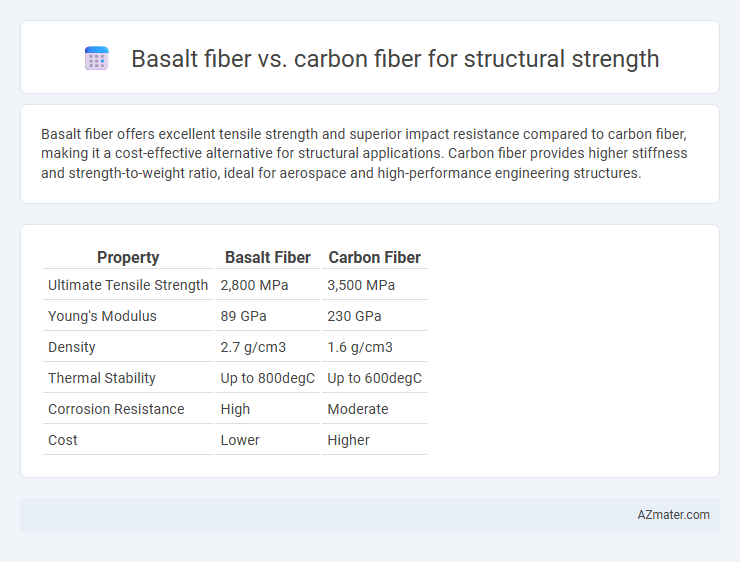Basalt fiber offers excellent tensile strength and superior impact resistance compared to carbon fiber, making it a cost-effective alternative for structural applications. Carbon fiber provides higher stiffness and strength-to-weight ratio, ideal for aerospace and high-performance engineering structures.
Table of Comparison
| Property | Basalt Fiber | Carbon Fiber |
|---|---|---|
| Ultimate Tensile Strength | 2,800 MPa | 3,500 MPa |
| Young's Modulus | 89 GPa | 230 GPa |
| Density | 2.7 g/cm3 | 1.6 g/cm3 |
| Thermal Stability | Up to 800degC | Up to 600degC |
| Corrosion Resistance | High | Moderate |
| Cost | Lower | Higher |
Introduction to Basalt and Carbon Fibers
Basalt fiber, derived from volcanic rock, exhibits excellent tensile strength and corrosion resistance, making it a cost-effective alternative to traditional reinforcement materials in construction. Carbon fiber, composed of thin strands of carbon atoms bonded into a crystalline structure, offers superior tensile strength and stiffness but at a higher cost and with greater energy consumption in production. Both fibers play critical roles in enhancing structural strength, with basalt fiber preferred for sustainable applications and carbon fiber utilized in high-performance engineering projects.
Material Composition and Manufacturing Process
Basalt fiber, derived from natural volcanic rock, offers superior thermal stability and chemical resistance compared to carbon fiber, which is composed primarily of carbon atoms arranged in a crystalline structure for exceptional tensile strength. The manufacturing process of basalt fiber involves melting basalt rock at around 1500degC and extruding it into fibers without the need for complex chemical treatments, resulting in a cost-effective and eco-friendly production method. Carbon fiber production requires a high-temperature carbonization process of polyacrylonitrile (PAN) or pitch fibers, producing materials with higher stiffness and strength but at a significantly greater cost and environmental impact.
Mechanical Properties Comparison
Basalt fiber exhibits high tensile strength ranging from 2,800 to 4,800 MPa, making it a robust alternative to carbon fiber, which typically offers tensile strength between 3,500 and 6,000 MPa. In terms of Young's modulus, basalt fiber ranges from 89 to 110 GPa, lower than carbon fiber's modulus of 230 to 600 GPa, indicating less stiffness but better impact resistance. Basalt fiber also demonstrates superior elongation at break (approximately 2.5 to 3%) compared to carbon fiber (about 1.5 to 2%), which translates to better flexibility and fracture toughness in structural applications.
Tensile Strength and Modulus
Basalt fiber offers a tensile strength ranging from 2,800 to 4,800 MPa, while carbon fiber typically exhibits higher tensile strength between 3,500 and 7,000 MPa. The tensile modulus of basalt fiber is generally between 85 and 110 GPa, compared to carbon fiber's significantly higher modulus, often exceeding 230 GPa. These properties make carbon fiber superior for applications demanding maximum structural strength and stiffness, whereas basalt fiber provides a cost-effective alternative with moderate mechanical performance.
Durability and Environmental Resistance
Basalt fiber offers superior durability with excellent resistance to chemical corrosion, UV exposure, and high temperatures, making it ideal for harsh environmental conditions. Carbon fiber provides exceptional structural strength with high stiffness-to-weight ratio but can degrade under prolonged UV exposure and is more susceptible to environmental factors without protective coatings. For long-term durability and environmental resistance, basalt fiber demonstrates greater resilience in aggressive or variable climates compared to carbon fiber.
Weight-to-Strength Ratio
Basalt fiber exhibits a high weight-to-strength ratio, offering excellent tensile strength while maintaining lower density compared to traditional materials. Carbon fiber surpasses basalt in strength-to-weight performance, featuring superior stiffness and tensile strength at an ultra-lightweight profile. Engineers often select carbon fiber for maximum structural efficiency, while basalt fiber provides a cost-effective alternative with competitive weight-to-strength characteristics.
Cost and Economic Considerations
Basalt fiber offers a cost-effective alternative to carbon fiber, with prices typically 30-50% lower, making it attractive for budget-sensitive structural applications. While carbon fiber provides superior tensile strength and stiffness, basalt fiber delivers adequate structural strength with better impact resistance and thermal stability at a fraction of the cost. Economic considerations favor basalt fiber for large-scale projects where reducing material costs and ease of production are critical factors without significantly compromising performance.
Applications in Structural Engineering
Basalt fiber offers excellent tensile strength, corrosion resistance, and cost-effectiveness, making it ideal for reinforcing concrete structures, bridge decks, and retrofitting applications in structural engineering. Carbon fiber provides superior stiffness, higher strength-to-weight ratio, and fatigue resistance, widely used in high-performance load-bearing components, seismic retrofitting, and aerospace structural applications. Choice between basalt and carbon fiber depends on project budget, environmental exposure, and required mechanical performance for specific structural engineering needs.
Sustainability and Environmental Impact
Basalt fiber offers a sustainable alternative to carbon fiber by utilizing abundant natural volcanic rock, reducing reliance on energy-intensive production processes that carbon fiber requires. Its biodegradability and lower carbon footprint contribute to a significantly reduced environmental impact, making it favorable for eco-conscious structural applications. While carbon fiber boasts superior structural strength and stiffness, basalt fiber provides a balanced combination of strength and sustainability for green construction projects.
Conclusion: Choosing the Right Fiber for Structural Strength
Basalt fiber offers high tensile strength, excellent thermal stability, and good resistance to chemical corrosion, making it a cost-effective alternative for structural applications where moderate strength is sufficient. Carbon fiber provides superior stiffness, higher tensile strength, and a better strength-to-weight ratio, making it ideal for demanding structural projects requiring maximum performance and lightweight solutions. Selecting the right fiber depends on balancing budget constraints, required strength levels, and environmental exposure for optimal structural integrity.

Infographic: Basalt fiber vs Carbon fiber for Structural strength
 azmater.com
azmater.com